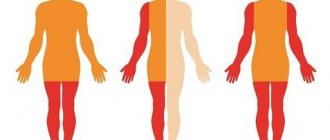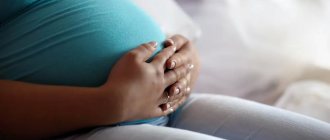Symptoms of neuroses
Sometimes parents either do not pay attention to the symptoms. The child begins to jump strangely and make movements that are similar to ritual ones. Someone, on the contrary, scolds the baby because he constantly bites his lip or “chews his collar,” chews a pen or pulls his hair. Others complain that the child is afraid to fall asleep. However, often the basis of all the described manifestations is a disease - obsessive-compulsive neurosis. Moreover, neurosis is not a harmless illness. It becomes a serious obstacle both in studies and in a person’s future life. But it turns out that when the baby has a fever or a runny nose, we run to the clinic. When there is clear evidence that the child has either experienced serious stress or has organic brain damage against which symptoms of neurosis develop, parents not only delay contacting a specialist, but also scold their children, aggravating their condition.
Nervous tics, like obsessive movements, are accompanied by deep emotions in the child. The baby is in a state of emotional stress. But all this does not pass without leaving a mark on the psyche.
Neurotic behavior of children/adolescents
Neurosis forces a person to behave in accordance with the level of anxiety, and sometimes suspiciousness, that is characteristic of a neurotic. This is the intensity of reactions and experiences that not only differ from the reactions of healthy people, but, most importantly, interfere with the personal life and professional activities of the patient himself.
Forms of neuroses in children:
In children under the age of 6-7 years, neurosis is detected, as a rule, only in the form of individual symptoms. As a rule, this is a demonstration of helplessness in the form of rolling on the floor screaming and crying, while they may hit their head, arms and legs on the floor. An equally striking manifestation of neurosis in children is neurotic stuttering, (logoneurosis) most typical for boys from 3 to 6 years old, i.e. during the period when speech formation occurs.
Essentially, this is a convulsive contraction of the muscles responsible for speech.
At school age, the presence of neurosis becomes clearly visible: it is pronounced anxiety or fears, because of which the child is ready to miss classes in clubs or school, refuse to go for walks, cry, withdraw into himself, and have difficulty falling asleep. Often there are such manifestations as twitching of the hands, sniffing or a certain stupor, accompanied by a decrease in self-esteem, unnatural movements, changes in facial expressions, decreased appetite, insomnia and tearfulness.
Another type of neurosis in adolescents is neurotic tics, which are more common in boys. This is either frequent blinking, or twitching of noses, eyebrows, shrugging of shoulders, and the like. There are also respiratory tics, as a persisting habit after suffering from a cold: coughing, sniffing, etc.
Enuresis of a psychogenic nature, as a reaction to psychological trauma or mental stress that is excessive for the child.
In adolescence, a neurotic state can manifest itself in constant irritation, incontinence and grumpiness unusual for age. At the same time, girls may predominantly experience fear of hypothetical diseases.
Example of neurotic behavior
An 8-year-old boy, usually moderately active, with good self-esteem, having gone with his parents to a cottage community for the summer, was faced with a situation where neighboring children of 10-12 years old refused to play with him during walks, citing the fact that he too small. His attempts to establish contact with them every walk led to even more aggressive refusals on their part. As a result, he felt like an outcast.
By mid-summer, the situation had changed: his peers arrived, who friendly invited him for walks and joint games.
During a stressful situation for him, his psyche resisted, forcing him to come up with new ways to establish communication, and he felt upset, resentful and angry, which was a normal, natural reaction to the situation. However, in the second half of the summer, his parents noticed that he began to withdraw more and more into himself, silently sad in solitude, his appetite decreased and the desire to participate in games with peers disappeared. This is how the boy developed neurosis.
I’ll say right away that the parents paid attention to this in time, and with the help of a psychotherapist, they quickly returned the boy to a healthy, cheerful state.
Neurotic behavior can also be caused by other disorders of the emotional and mental sphere. It is important to understand that the development of neurosis can make a neurotic person more prone to what are called “internalizing disorders”, for example:
- Generalized anxiety disorder
- Depression
- Obsessive-compulsive disorder
- Social phobia
- Post-traumatic stress disorder
- Panic disorder
- Sociopathic personality disorder
Symptoms of neurosis do not include delusions or hallucinations, which are symptoms of psychotic disorders in which the patient loses touch with reality. Instead, he dwells on his own negative emotions and failures, real or imagined.
How do neuroses and obsessive movements arise in children?
A simple example. The child is weaned. He starts sucking his thumb. This turns into an obsessive movement, since for an adult the process of “weaning” a two or two and a half year old child is natural, but the baby experiences unprecedented stress. He can replace the finger with a pillow, a toy, or a pajama sleeve, but the essence remains the same - the child acquires an obsessive movement, indicating the presence of psychological trauma. As a result, if you pay attention to alarming symptoms, sooner or later you will have to start treatment for neurosis.
Often, neurotic conditions appear in cases of family divorces, scandals, contradictions between parents and grandparents; sometimes dictates in the family also result in stress and nervous tics. Children with a weak type of nervous system, when they find themselves in a school group, also react with neuroses to changes in life.
However, special attention must be paid to those children who have suffered traumatic brain injuries or suffer from allergic diseases. Or they suffer from chronic diseases that lead to exhaustion of the nervous system.
Prevention and prognosis
Neuroses are reversible conditions, i.e.
With adequate treatment and the creation of a favorable environment in the family and school, all symptoms are completely relieved. The best prevention of neuroses in children is the mutual love of parents in a complete family. If the parents' relationship is harmonious, children rarely suffer from neuroses. All the troubles and stress received outside the home are easily smoothed out within their own walls.
Children growing up in single-parent families need the help of a psychologist. There are many effective techniques that compensate for any problems.
The team of doctors and psychologists at the SM-Doctor medical clinic will help children and adults cope with neurosis and overcome crisis periods in life without loss. Contact professionals at a convenient time!
Where to start treating neuroses?
Go to specialists who comprehensively examine the child’s body. By the way, from the above it follows that children with chronic diseases (including those suffering from allergic reactions) are prone to neuroses. Early diagnosis of symptoms and prevention, observation by somnologists, neurologists and psychologists will help to adapt to society, avoid neurotic manifestations, and strengthen the nervous system.
Such comprehensive examinations are carried out at the LINGUABONA clinic. Experts say that by starting to solve the problem at an early stage, you can achieve excellent results. Having understood the grain of the problem, they begin to select methods of treatment, rehabilitation, and select the necessary medications.
Features of treatment
An experienced psychotherapist has a sufficient number of methods for identifying signs and knows how to cure neurosis in a child 7 years old and younger. In each specific case, the age of the baby and the form of the disorder are taken into account. An important stage is diagnosis. The doctor must make sure that there are no organic diseases of the nervous system. For this purpose, examination of cerebral vessels, CT, and electroencephalogram are performed. In addition, the conversation reveals signs of neurotic reactions.
The treatment arsenal includes homeopathic and medicinal preparations. But the main remedy is psychotherapy, during which the doctor conducts:
- study and correction of the psychological climate in the family;
- activities with the child in the form of games, through which the child learns to overcome difficult situations;
- physiotherapeutic procedures for sedative effects.
Only a specialist knows all the subtleties of how to treat neurosis in a 5-year-old child, toddlers and younger schoolchildren. Never self-medicate.
| Service | Price |
| Initial consultation by phone | for free |
| Detailed consultation by phone/Skype | from 1,000 rubles |
| Consultation with a psychiatrist in the clinic | from 1,500 rubles |
| Home visit | from 5,000 rubles |
| Urgent home visit | from 8,000 rubles |
| Reception of children and teenagers | from 5,000 rubles |
| Reception of adults | from 7,000 rubles |
| Constant observation by a psychiatrist | from 10,000 rubles |
Psychotherapist I.G. Gernet, who practices in Moscow and has extensive experience working with children, offers his assistance in the treatment of childhood obsessive states and other forms of neurosis.
We are accepting parents whose children over 2 years old, preschoolers 4-5 years old and schoolchildren 6-7 years old suffer from symptoms of strange behavior. Based on clinical diagnosis, the cause of the disorder is determined, and you yourself decide on the need for psychological correction of the disorder. Your child will get rid of the habit of biting his nails, sucking his fingers, and grinding his teeth. He will lose his fear of the dark, dogs and other fears that prevent him from living peacefully. In this case, only you and the doctor will know about the treatment, who will ensure complete confidentiality. Share:
Obsessive Action Syndrome
Obsessive behavior syndrome can take three forms:
- One-time, which implies that the signs of neurosis can last for a long period, being at the same level of intensity.
- The remitting form characterizes a situation when signs of neurosis periodically worsen and then fade.
- The progressive form of neurosis implies that the symptoms only begin to worsen over time.
Obsessive behavior syndrome may occur due to the influence of biological factors, such as heredity or the presence of organic changes in the brain. But there are cases when acute psychological trauma and severe losses in a person’s life contribute to the disease. But obsessive actions can only arise in a patient if there is a biological tendency. If it is not there, the psyche reacts predominantly in a completely different way.
Pathogenesis
As a rule, the occurrence of obsessive movements is associated with stress. Autostimulation is a term used to describe frequently repeated movements that help a person with certain developmental disorders cope with stress. This often occurs in autism .
Monotonous movements that are repeated, or a series of such movements, develop as a result of disturbances at the mental and emotional levels. Essentially, these movements are obsessive-compulsive disorder. Today, work is still underway to study the pathogenesis of this phenomenon. There are many theories about it. In particular, the influence on the development of this pathology of a hereditary factor and the involvement of the dopamine system in the pathogenesis of OCD is being studied. The involvement of the norepinephrine and GABAergic neurotransmitter systems in the pathological process is also being studied.
What can a parent do?
- understand what OCD is, its causes and myths,
- find a suitable psychotherapist for correction,
- learn to recognize and respond to symptoms,
- Don't blame yourself for your child's OCD; even the worst upbringing does not cause this disorder,
- do not scold the child; It's not your child's fault, he's not trying to get attention or doing it on purpose.
- you and your child deserve relief from the symptoms of the disorder that disrupt normal family life, friendships, and schooling. By receiving psychotherapy, your child can learn to manage OCD symptoms.
There is currently no cure for OCD. However, just as a child with asthma, allergies, or diabetes learns to manage their condition through treatment, a child with OCD can learn to manage OCD symptoms.
Obsessive behavior in adults
Experts divide manifestations of obsessive actions in adults into several categories, including:
- Classic tics, which are manifested by rapid movements of the head or neck. Also, tics of this type can also manifest themselves in sound, for example, constant mooing, coughing and much more.
- The stereotypical category includes frequent rocking in different directions, tapping fingers on the table surface, and jerking the leg. With such behavioral disorders, there are no prodominal signs that are harbingers of the onset of the disease.
- Behavioral disorders that cause physical harm to the patient - hair pulling, scratching or picking at skin, nail biting.
Such actions are performed unconsciously, since a person involuntarily performs certain actions. The tick stops for a while if requested by loved ones or if a situation arises that will distract from the “procedures.” However, after some time, this situation will certainly repeat itself again and again.
Diet
Diet for the nervous system
- Efficacy: therapeutic effect after 2 months
- Timing: constantly
- Cost of food: 1700-1800 rubles per week
In case of neurosis, it is imperative to compensate for the deficiency of minerals and vitamins, since their deficiency can provoke such manifestations. It is recommended to consume the following foods:
- All types of greens, cabbage, asparagus.
- Bananas, citrus fruits
- Liver.
- Fish.
- Seeds, nuts.
- Vegetable oils.
- Meat.
- Sea buckthorn, rose hips, currants.
The following should be excluded from the menu:
- Sweets.
- Mayonnaise, margarine.
- Alcohol.
- Strong tea and coffee, soda.
You should also reduce the amount of foods containing starch in your diet.









